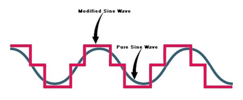- Joined
- 27 Jan 2008
- Messages
- 27,761
- Reaction score
- 3,365
- Location
- Llanfair Caereinion, Nr Welshpool
- Country

This is the big problem, any coil of wire will turn simulated sine waveHow does a micro-generator tell whether the incoming power is from the real mains or from another micro-generator. ?
Maybe ( I don't know ) the real mains has a high frequency marker signal added to it and if this marker is not there then the micro-generator will shut down,
 into a more conventional sine wave, so if the output supplies a transformer it knocks off the corners, so there are three methods to switch off the grid tie inverter, under voltage, over voltage or not 50 Hz.
into a more conventional sine wave, so if the output supplies a transformer it knocks off the corners, so there are three methods to switch off the grid tie inverter, under voltage, over voltage or not 50 Hz.But there must be a delay between switching off and switching back on again, or a street with 30 grid tie inverters could keep each other going.
This in the main means a manual reset, the same with EV chargers, often a manual reset is required, so a short brown out can have a knock on effect, which can go either way, reducing or increasing load.
It is rare to have power cuts two days on the run, at least where I live, so as long as the EV has enough capacity for 2 days running there is not a problem.
However the milkman across the road to where I use to live had a Renault kangoo van, which had a charging rate of 3.5 kW later versions were 7 kW, and a range of 120 miles, his mile round I think he said was 64 miles, so he expected no problems, and due to carrying milk the heater was rarely used, only used to demist, so there should have been no problems, however there was, if there was a brown out he was unaware of the charging being stopped, so would get up to a vehicle not fully charged.
I thought charge points like the one at work would charge an EV at 22 kW, but it seems many can't use 3 phase or DC and even on single phase some are only 3.5 kW clearly designed for Europe with 16 amp outlets, and some granny leads only 2 kW.
The early versions had a 22 kWh battery, even that small at 3.5 kW it takes around 7 hours to fully charge, which normally should be enough, but since we sleep for around 8 hours, very easy not to realise the charger needs resetting.
